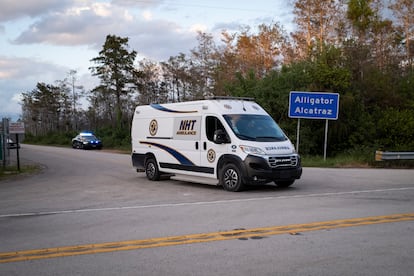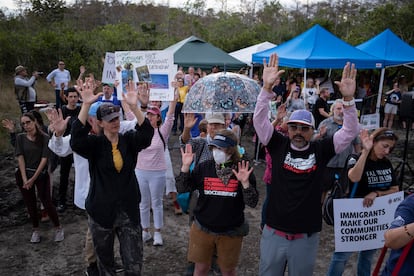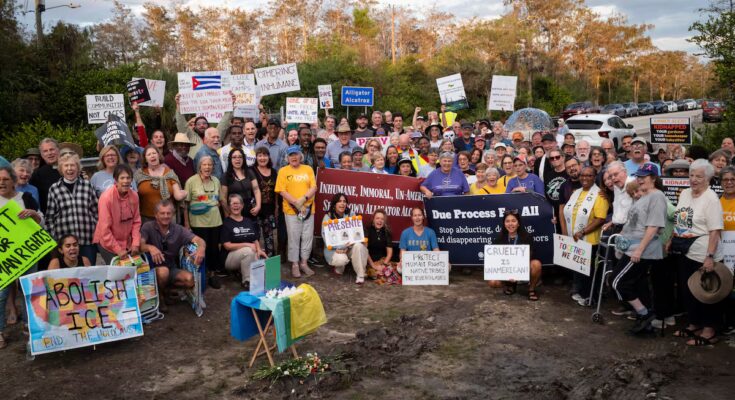About 90 kilometers from Miami, on a lonely curve of the Tamiami Trail surrounded by wetlands and with no cellphone signal, after passing airboat operations and the Miccosukee tribal village, a blue sign announces that the Alligator Alcatraz detention center is approaching. The official sign is obliterated by graffiti: “Fuck ICE”.
Last Sunday afternoon, on the stretch of road in front of the remote center in the middle of the mangroves of the Everglades, more than 200 people gathered to ask for its closure and denounce the treatment reserved for immigrants detained in the United States. These vigils in front of the center, located in the old Dade-Collier airport, took place for 14 consecutive Sundays and became a meeting point for activists, clerics and families of prisoners. November 2 coincided with a national day of protest: the Missing in America Day of Action, which organized more than 140 events across the country.
Since its express opening in July, Alligator Alcatraz has become a national symbol of the Donald Trump administration’s immigration policies. During this vigil, worshipers and activists joined the national clamor for the closure of all immigration detention centers and an end to Immigration and Customs Enforcement (ICE) raids.
Some attendees arrived by bus from Fort Myers and Naples on Florida’s west coast. Others drove in from Miami, Fort Lauderdale, Palm Beach and other East Coast cities. The participants form a semicircle on a piece of land which, due to much use, has been left without grass and which the rains have transformed into a quagmire. Some set up folding chairs and awnings; others have mats to sit on the ground, but most remain standing in the mud. Almost all of them carry signs with messages in English such as “No human is illegal”, “Abolish ICE” or “Stop the abuses, detentions and deportations”.
Noelle Damico of the Workers Circle, which organizes the vigils at Alligator Alcatraz, said last Sunday’s demonstration also included protests in front of Home Depot stores and at Day of the Dead altars, commemorating those who have died in the custody of immigration authorities this year.
“People don’t stand by and watch. Every week new people come to the vigil who then return to their communities and share the experience, and new vigils have been started in Sarasota, Orlando, Tallahassee and other parts of the country,” Damico says. Just over a week ago, a training course on how to organize a vigil was held, for which more than 4,000 people signed up. “Those people told others and now it’s spreading like wildfire, from Alaska to Hawaii, from Oklahoma to Florida and Boston, and continuing to spread. We want anyone who wants to be able to organize a vigil,” he adds.
The growing movement has kept a spotlight on the center, which has been surrounded by controversy since its inception. Alligator Alcatraz was built with canvas tents in just eight days in late June and began receiving inmates in early July, after a booster visit by President Donald Trump. It has faced numerous complaints of poor conditions, lack of access to immigration lawyers and courts, as well as environmental damage. Environmental groups and the Miccosukee tribe – which considers this area its ancestral territory – have filed a lawsuit claiming that the operation would cause irreparable damage to the fragile Everglades ecosystem. In August, a judge ordered the camp dismantled, but the state appealed and the case was left in limbo after the federal government closed the camp. In the meantime the center continues to function.
The name of the national day, “Missing in America,” alludes to complaints from immigrant advocacy groups that hundreds of detained people do not appear in ICE’s online database and their lawyers and relatives do not know their whereabouts. A lawsuit from the American Civil Liberties Union (ACLU) refers to Alligator Alcatraz as “a black hole,” with people “missing” and “off the radar” of the immigration system.
A vigil in the heart of the Everglades
The Sunday vigil passes with a solemn tone, just interrupted every now and then by the horn of a car passing by on the road. Pastor Roy Terry, of the Cornerstone United Methodist Church in Naples, serves as master of the ceremony and provides the only microphone available to those who will share testimonies, prayers and songs. Religious leaders from different churches and faiths, pro-immigrant activists and relatives of detainees take turns addressing the crowd. Across the street, armed guards and police guard the entrance, while an ACLU legal observer closely examines the interaction between attendees.

One after another, prayers and emotionally charged testimonies followed, including that of Arianne Betancourt, a 32-year-old resident of Miami. The young woman reported that her father, Justo Betancourt, has been detained in this center since last week. The man, of Cuban origin and resident in the United States for 36 years, had served a prison sentence and was on parole. However, when he showed up for a routine check-in at ICE, he was arrested. Overwhelmed with tears, Arianne said her father “made a mistake, but he has already served his sentence, he went to school, he found Jesus and goes to church every Sunday.” The man suffers from diabetes and neuropathy and requires seven different medications, but authorities asked him to choose just one, his daughter said. “This is illegal, everyone has the right to a fair trial,” he declared, receiving a standing ovation from the audience.
Betancourt’s case is not isolated. At the vigil is Maria Bilbao, coordinator of the American Friends Service Committee (AFSC), who is part of a group that has gathered outside the ICE offices in Miramar, north of Miami — where Betancourt was arrested — to pray for detainees, and says she has observed a troubling pattern in recent weeks: ICE makes appointments on weekends and detains those people. “This is new. The majority are elderly Cubans, some with health problems. In other words, where will they be deported? To a third country?” he asks.
The sense of urgency resonates among religious leaders like Pastor Roy Terry, who believes the country is experiencing “one of the greatest moral crises of our time” which, in his view, makes it essential to “raise your voice and take a stand.” He points out that several civil rights organizations have sent at least four letters to the State of Florida requesting access to the center, but have received no response. “If there is a lack of transparency, that indicates there is something they don’t want us to see,” he points out.

So far only priests of the Catholic Church have been allowed to enter Alligator Alcatraz and celebrate mass for the inmates. The Archdiocese of Miami did not respond to a request for comment on this report.
Confusion over the whereabouts of detainees is a recurring theme among those accompanying these vigils. The Rev. Tony Fisher of the Unitarian Universalist Congregation of Greater Naples, arriving on a bus with more than 40 people from his church, said he had preached that morning about the anguish of not knowing where the inmates are.
“I can’t imagine the stress this causes on the families, on the lawyers, on the detainees themselves. I can’t imagine what the families feel when they don’t know. (The detainees) could be in El Salvador, in Africa – where we have agreements to send people -, they could be in Louisiana, or even here,” he says, pointing towards the entrance of the center.
Authorities have denied allegations of mistreatment or poor conditions in detention centers and say detainees are provided adequate food, medical care and opportunities to communicate with family members and lawyers.
Among the spiritual leaders who have accompanied the vigils since their inception is Betty Osceola, a member of the Miccosukee tribe and well-known environmental activist. Like almost every Sunday, he brought awnings, tables and audio equipment in his truck; He said a prayer in his native language at the start of the vigil and is now burning sage at the back of the crowd. The stinky smoke adds mysticism to the prayer recited by a shepherd.
Speaking firmly, Osceola recalls the weight of history: “My ancestors have been through a lot: displacement, intentional massacres,” he says. “We go through cycles of discriminating against people. We’re in one of those cycles now. This country was built by everyone, and it’s going to be up to everyone to continue to move forward and prosper. The idea that America is just for a few individuals doesn’t make sense in a nation of immigrants.”
Almost at dusk, as the vigil comes to an end, Damico places a small table with colored tablecloths and candles in front of the microphone and explains that it is an altar for the Day of the Dead, in honor of the 25 people who died in ICE custody this year. Then read their names, ages, places of origin and where they died. Some in the crowd wipe away tears or shake their heads.



